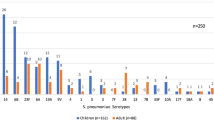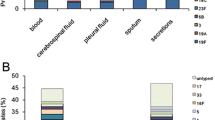Abstract
Macrolide resistance mechanisms in 89 Streptococcus pneumoniae strains isolated from several clinical samples between February 2007 and May 2009 were investigated. Erythromycin resistance was noted in 35 (40%) S. pneumoniae strains. In these strains, the most frequent resistance phenotype was cMLSB (74%), and the most frequent resistance genotype was ermB (82%). Both ermB and mefA genes were positive in 20% of macrolide-resistant strains. While no resistance to vancomycin, linezolid and telithromycin was noted in 89 S. pneumoniae strains, 12 (13%) strains were penicillin resistant, 26 (30%) strains were clindamycin resistant, 35 (40%) were azithromycin resistant, 32 (36%) strains were tetracycline resistant, and 1 (1%) strain was levofloxacin resistant. The serotype distribution of 35 macrolide-resistant S. pneumoniae strains revealed that the most frequent serotype was serogroup 19 (45%). Multidrug resistance was present in 19 (86%) of 22 strains carrying only the ermB resistance gene. No clonal dissemination was noted in the macrolide-resistant pneumococcal strains. These findings suggest that macrolide resistance rates, resistance phenotype and genotype, as well as resistant serotypes of S. pneumoniae strains should be continuously monitored in our country.

Similar content being viewed by others
References
Leclercq R, Courvalin P. Resistance to macrolides and related antibiotics in Streptococcus pneumoniae. Antimicrob Agents Chemother. 2002;46:2727–34.
Gulay Z, Ozbek OA, Bicmen M, Gur D. Macrolide resistance determinants in erythromycin-resistant Streptococcus pneumoniae in Turkey. Jpn J Infect Dis. 2008;61:490–3.
Farrell DJ, Morrissey I, Bakker S, Morris L, Buckridge S, Felmingham D. Molecular epidemiology of multiresistant Streptococcus pneumoniae with both erm(B)- and mef(A)-mediated macrolide resistance. J Clin Microbiol. 2004;42:764–8.
Sutcliffe J, Grebe T, Tait-Kamradt A, Wondrack L. Detection of erythromycin-resistant determinants by PCR. Antimicrob Agents Chemother. 1996;40:2562–6.
Tait-Kamradt A, Davies T, Cronan M, Jacobs MR, Appelbaum PC, Sutcliffe J. Mutations in 23S rRNA and ribosomal protein L4 account for resistance in pneumococcal strains selected in vitro by macrolide passage. Antimicrob Agents Chemother. 2000;44:2118–25.
Reinert RR, Ringelstein A, van der Linden M, Cil MY, Al-Lahham A, Schmitz FJ. Molecular epidemiology of macrolide-resistant Streptococcus pneumoniae isolates in Europe. J Clin Microbiol. 2005;43:1294–300.
Bozdogan B, Appelbaum PC, Kelly LM, Hoellman DB, Tambic-Andrasevic A, Drukalska L, et al. Activity of telithromycin and seven other agents against 1034 pediatric Streptococcus pneumoniae isolates from ten central and eastern European centers. Clin Microbiol Infect. 2003;9:653–61.
Wierzbowski AK, Nichol K, Laing N, Hisanaga T, Nikulin A, Karlowsky JA, et al. Macrolide resistance mechanisms among Streptococcus pneumoniae isolated over 6 years of Canadian Respiratory Organism Susceptibility Study (CROSS) (1998 2004). J Antimicrob Chemother. 2007;60:733–40.
Felmingham D, Cantón R, Jenkins SG. Regional trends in beta-lactam, macrolide, fluoroquinolone and telithromycin resistance among Streptococcus pneumoniae isolates 2001–2004. J Infect. 2007;55:111–8.
Clinical and Laboratory Standards Institute. Methods for dilution antimicrobial susceptibility test for bacteria that grow aerobically (Approved Standard M7–A6), 7th ed. Wayne: Clinical and Laboratory Standards Institute; 2006.
Clinical and Laboratory Standards Institute. Performance standards for antimicrobial susceptibility testing (17th Informational Supplement; CLSI document M100-S17). Wayne: Clinical and Laboratory Standards Institute; 2007.
Calatayud L, Ardanuy C, Cercenado E, Fenoll A, Bouza E, Pallares R, et al. Serotypes, clones, and mechanisms of resistance of erythromycin-resistant Streptococcus pneumoniae isolates collected in Spain. Antimicrob Agents Chemother. 2007;51:3240–6.
Klugman KP, Capper T, Widdowson CA, Koornhof HJ, Moser W. Increased activity of 16-membered lactone ring macrolides against erythromycin-resistant Streptococcus pyogenes and Streptococcus pneumoniae: characterization of South African isolates. J Antimicrob Chemother. 1998;42:729–34.
Sørensen UB. Typing of pneumococci by using 12 pooled antisera. J Clin Microbiol. 1993;31:2097–100.
McEllistrem MC, Stout JE, Harrison LH. Simplified protocol for pulsed-field gel electrophoresis analysis of Streptococcus pneumoniae. J Clin Microbiol. 2000;38:351–3.
Tenover FC, Arbeit RD, Goering RV, Mickelsen PA, Murray BE, Persing DH, et al. Interpreting chromosomal DNA restriction patterns produced by pulsed-field gel electrophoresis: criteria for bacterial strain typing. J Clin Microbiol. 1995;33:2233–9.
Farrell DJ, Couturier C, Hryniewicz W. Distribution and antibacterial susceptibility of macrolide resistance genotypes in Streptococcus pneumoniae: PROTEKT year 5 (2003–2004). Int J Antimicrob Agents. 2008;31:245–9.
Borg MA, Tiemersma E, Scicluna E, van de Sande-Bruinsma N, de Kraker M, Monen J, et al. Prevalence of penicillin and erythromycin resistance among invasive Streptococcus pneumoniae isolates reported by laboratories in the southern and eastern Mediterranean region. Clin Microbiol Infect. 2009;15:232–7.
Berkiten R. Streptococcus pneumoniae in Turkey: the rates of antibiotic resistance, erythromycin resistance phenotypes and serotypes. ANKEM Derg. 2006;20:114–24.
Reinert RR. The antimicrobial resistance profile of Streptococcus pneumoniae. Clin Microbiol Infect. 2009;15(Suppl 3):7–11.
Bae S, Lee K. Distribution of capsular serotypes and macrolide resistance mechanisms among macrolide-resistant Streptococcus pneumoniae isolates in Korea. Diagn Microbiol Infect Dis. 2009;63:213–6.
Gur D, Guciz B, Hascelik G, Esel D, Sumerkan B, Over U, et al. Streptococcus pneumoniae penicillin resistance in Turkey. J Chemother. 2001;13:541–5.
Leclercq R. Mechanisms of resistance to macrolides and lincosamides: nature of the resistance elements and their clinical implications. Clin Infect Dis. 2002;34:482–92.
Klugman KP. Clinical impact of antibiotic resistance in respiratory tract infections. Int J Antimicrob Agents. 2007;29(Suppl 1):S6–10.
Isozumi R, Ito Y, Ishida T, Osawa M, Hirai T, Ito I, et al. Genotypes and related factors reflecting macrolide resistance in pneumococcal pneumonia infections in Japan. J Clin Microbiol. 2007;45:1440–6.
Acknowledgments
This study was supported by project TPF-07024 of the Adnan Menderes University Research Foundation. It was presented at the ECCMID, Vienna, 2010.
Author information
Authors and Affiliations
Corresponding author
Additional information
An erratum to this article can be found at http://dx.doi.org/10.1007/s10156-011-0290-6
About this article
Cite this article
Telli, M., Eyigör, M., Gültekin, B. et al. Evaluation of resistance mechanisms and serotype and genotype distributions of macrolide-resistant strains in clinical isolates of Streptococcus pneumonia in Aydın, Turkey. J Infect Chemother 17, 658–664 (2011). https://doi.org/10.1007/s10156-011-0238-x
Received:
Accepted:
Published:
Issue Date:
DOI: https://doi.org/10.1007/s10156-011-0238-x




